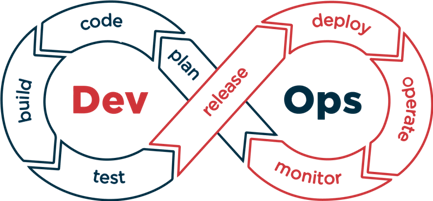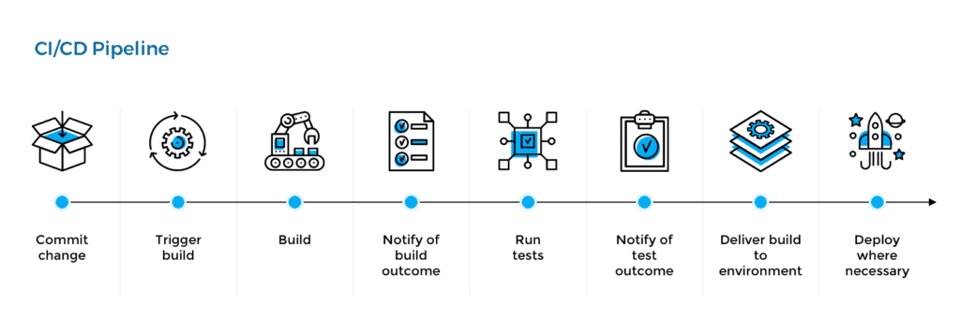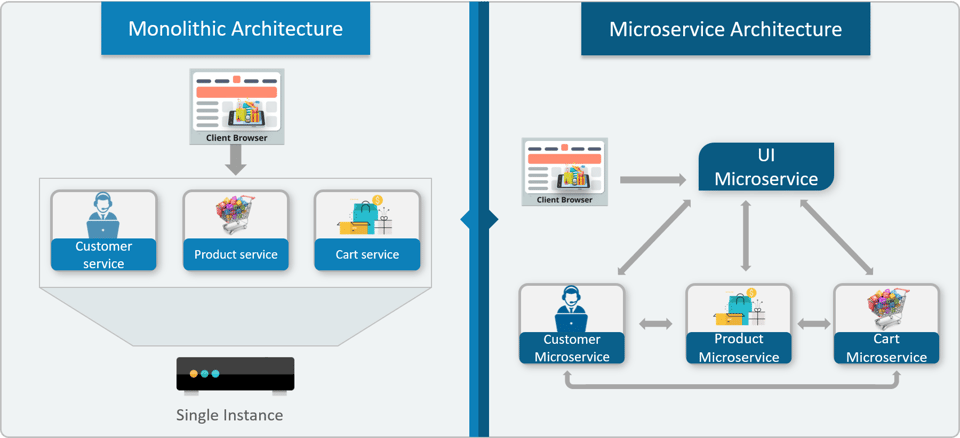DevOps Evolution
DevOps is taking the IT world by storm. Harvard Business Review found that 86% of enterprises are now employing DevOps practices, with survey participants specifically mentioning that their companies recognize the importance of developing and deploying new software more quickly.
IT has transitioned from simply a cost center that supports the business to a core pillar to drive customer experience, real-time intelligence, and new revenue opportunities.
Many organizations are trying to both drive innovation, agility, and speed, while at the same time increasing security-governance, and reducing cost. Many times, these can be opposing forces in traditional IT environments.
Enter DevOps
DevOps aims to solve the challenges of moving fast while maintaining a high degree of governance. For a while, DevOps was about aligning Developers and Operations to streamline software delivery utilizing agile methodology. While this is still true in many ways, DevOps has evolved to include more parts of the organization including business, finance, and security. Read more on the DevOps Security Challenges.
What is DevOps?
To understand DevOps, it’s important to first know what DevOps really means. Coined in 2009 by IT consultant Patrick DuBois, DevOps is the integration of software development and IT operations teams to create more agile, innovative, and secure IT solutions.

At its core, DevOps is the idea of breaking down barriers and silos across IT operations, development teams, business owners, and even security, all working together in a way that is highly integrated. The goal is to be able to deliver quality products and solutions quickly as minimum viable products, then iterate on them over time.
Today, in a world where IT infrastructures and deployment models are becoming increasingly decentralized and complex, a streamlined DevOps strategy is critical to a company’s ability to keep pace with competitors and innovation, while managing customer expectations.
Quick Takeaways
- DevOps aims to drive rapid and frequent software and technology changes while not compromising governance and compliance
- Modern DevOps integrates the development, operations, business, finance, and security teams to optimize the software development lifecycle.
- Technology of DevOps include Code Repository, CI/CD pipelines, Kubernetes, and APM or Observability.
- DevSecOps aims to integrate security into every step of the DevOps process to ensure good security practices are engrained throughout the process.
DevOps Components
Code Repository
Strictly from a technology perspective, this is where all the magic starts. Modern source control management (SCM) solutions such as GitHub or GitLab have helped power the open-source movement as well as DevOps. Utilizing these tools with a well-defined branching strategy allows many resources to contribute code while still ensuring that the proper governance and code quality is maintained. SCM tools have built-in mechanisms for code reviews, allowing for peer-reviews to be part of the process before anything is deployed to production. Some great first steps in implementing DevSecOps are required peer reviews of code, threat modeling, and utilizing code security scanning tools. Organizations that deploy this properly can see the benefits of “democratizing” the development process, allowing anyone organization-wide to contribute code while keeping the governance and administration with the development subject matter experts.
CI/CD
Continuous integration and continuous delivery - better known as CI/CD - is where the automation starts. One of the virtues of DevOps is the ability to deploy automatically, frequently, while taking advantage of small batch sizes. There are multiple advantages to doing smaller more frequent code pushes in a fully automated fashion.
CI/CD is a pipeline or process that takes the code committed by a developer and performs automated actions on it – testing, linting, code coverage, container builds and even deployment to development or production environments. Many of the SCM tools have their own built-in CI/CD mechanisms, as do the major cloud providers. This functionality allows developers to make code changes frequently and securely without the need for cumbersome release strategies or disruption of larger business operations.
We suggest additional steps for automated security scanning (DevSecOps) and automated testing (unit testing, end-to-end testing, user experience). When deploying code frequently in small batches combined with automated testing and scanning, it’s much easier to fail a build in this pipeline and quickly identify the issue, resolve it, and redeploy.

Kubernetes & Microservices
We have talked so far about agility and speed and the ability to deploy code quickly, more frequently, with automated testing and security scanning.
While this is great, how can the business deploy frequently without disrupting business operations?
Enter microservices and Kubernetes.
While microservices is more of an application architecture, Kubernetes is the technology that helps enable this. Kubernetes is a container orchestration system that empowers many microservices deployments.
Applications designed with a microservices architecture are a collection of independent services. Each of these services is a component of the application and can be updated independently unlike traditional monolithic applications. When microservices architecture is paired with K8s (Kubernetes), the result is an opportunity to utilize a deployment methodology referred to as Blue/Green. This allows an upgraded version of a service/application to be deployed with zero interruption to the user.
One example would be the “Order Reporting” service of an application updating from version 1.3 to 1.4 live, without impacting any users. While this may spike the blood pressure of any legacy application owner, many modern SaaS applications push hundreds of updates a day without impacting any users.
Microservices have transformed the ability to deliver quality applications at scale while maintaining agile IT infrastructures.
Unlike self-contained monolithic applications, which are time consuming to update and redeploy, applications built on microservices can use CI/CD methods for fast, frequent, and reliable releases.

APM and Observability
An area that is often overlooked in a DevOps deployment is APM (Application Performance Monitoring) and Observability. Both greatly impact customer experience and MTTR (Mean time to recovery).
The idea of observability is more than advanced monitoring. It is actively collecting and analyzing every piece of information across infrastructure, systems, application, and database. This allows for proactive identification of issues in the system, and the ability to react quickly while drilling down into the exact issue.
While deploying features quickly is important, end user experience is critical. APM is part of a well-developed observability practice that translates IT metrics into meaningful business value, pulling back the curtain on how users are interacting with your application.
DevOps embraces continuous metrics monitoring and system logs to optimize application performance and, ultimately, the end user experience. DevOps teams analyze logs and data to quickly recognize and resolve issues, recognize how updates impact UX, and access real-time insights about the performance success of their infrastructure.
DevSecOps
DevSecOps is the integration of security throughout the entire DevOps lifecycle. It shifts security left so that it’s prioritized earlier and more frequently throughout the DevOps lifecycle. This helps to avoid larger and more costly security issues from occurring after deployment, such as data breaches, unexpected service interruptions, or extended downtime.
What is DevOps advisory?
DevOps advisory comes in several forms and can be tailored to an organization’s needs. As discussed earlier, many aspects of adopting an DevOps culture involves changes within the organization as well as the technology components.
From an advisory perspective, implementing DevOps best practices begins with an assessment of desired business outcomes, followed by a review of organizational and technology maturity and capabilities.
Many organizations look outside their organizations for consultants and agencies with the right expertise to guide their DevOps strategy. Protera offers a multipronged, platform-based DevOps assessment and service that empowers clients to achieve important DevOps outcomes, such as:
- Code governance
- Rapid deployment cycles
- Platform security
- High availability and observability
- Reduced MTTR
These services are especially valuable for users of SAP and other mission critical enterprise software systems, all which include many complex moving parts to be managed throughout the DevOps lifecycle.
What do Protera’s DevOps services include?
Protera’s DevOps services encapsulate four important areas that align with steps in the DevOps model:
- Code Repository Best Practices and Governance (Plan, Code) - GitHub/GitLab security, branch & merge strategies, code scanning for vulnerabilities, passwords or API keys
- CI/CD Pipeline Governance (Build, Test) - Pipeline monitoring, security scanning of build containers or systems, supply chain / dependency scanning, automated testing / linting of code
- Deployment Design & Governance (Release, Deploy) - Blue/Green deployment, K8s design and security, high availability and scaling
- APM & Observability (Operate, Monitor) - Observability (if it moves, collect telemetry on it), external application security scanning, find and identify issues quickly with full visibility
Whether you are just starting to build your cloud strategy, transforming legacy applications, or looking to empower developers, we can help you optimize cost and drive value quickly.
Protera’s DevOps Services: Client Use Cases
When considering the true value of DevOps, Protera clients pursue managed DevOps services to deliver value quickly without disruption. In a world where the pace of business is only getting faster, this is a critical capability for every business to have.
At Protera, our clients are utilizing DevOps services in several ways, including:
- Automating disaster recovery solutions in the cloud
- Rapidly deploying B2B and B2C applications
- Building servers that ensure security, compliance, and governance
- Maintaining and leveraging shared code repository
- Solve individual business problems with DevOps principles
No matter what your solution needs are, Protera’s expertise, automation capabilities, and proven processes can help you build, execute, and maintain a DevOps strategy that delivers the most value for your organization — all while you stay focused on core business priorities.
Learn more here about Protera cloud managed services or contact us to begin your DevOps strategy.